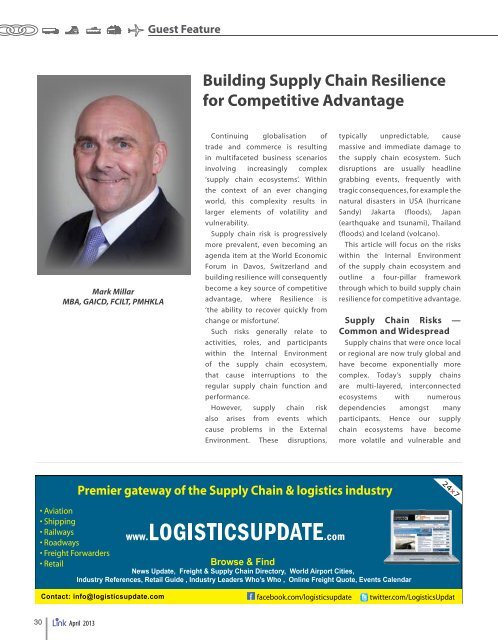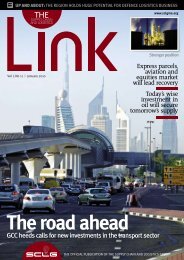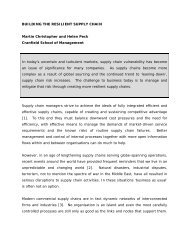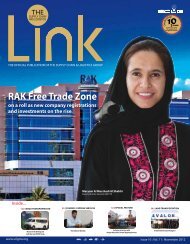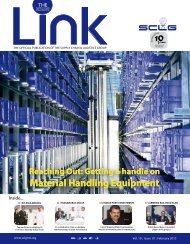Guest Fe<strong>at</strong>ureBuilding Supply Chain Resiliencefor Competitive AdvantageMark MillarMBA, GAICD, FCILT, PMHKLAContinuing globalis<strong>at</strong>ion oftrade and commerce is resultingin multifaceted business scenariosinvolving increasingly complex‘supply chain ecosystems’. Withinthe context of an ever changingworld, this complexity results inlarger elements of vol<strong>at</strong>ility andvulnerability.Supply chain risk is progressivelymore prevalent, even becoming anagenda item <strong>at</strong> the World EconomicForum in Davos, Switzerland andbuilding resilience will consequentlybecome a key source of competitiveadvantage, where Resilience is‘the ability to recover quickly fromchange or misfortune’.Such risks generally rel<strong>at</strong>e toactivities, roles, and participantswithin the Internal Environmentof the supply chain ecosystem,th<strong>at</strong> cause interruptions to theregular supply chain function andperformance.However, supply chain riskalso arises from events whichcause problems in the ExternalEnvironment. These disruptions,typically unpredictable, causemassive and immedi<strong>at</strong>e damage tothe supply chain ecosystem. Suchdisruptions are usually headlinegrabbing events, frequently withtragic consequences, for example then<strong>at</strong>ural disasters in USA (hurricaneSandy) Jakarta (floods), Japan(earthquake and tsunami), Thailand(floods) and Iceland (volcano).This article will focus on the riskswithin the Internal Environmentof the supply chain ecosystem andoutline a four-pillar frameworkthrough which to build supply chainresilience for competitive advantage.Supply Chain Risks —Common and WidespreadSupply chains th<strong>at</strong> were once localor regional are now truly global andhave become exponentially morecomplex. Today’s supply chainsare multi-layered, interconnectedecosystems with numerousdependencies amongst manyparticipants. Hence our supplychain ecosystems have becomemore vol<strong>at</strong>ile and vulnerable and30 April 2013
Guest Fe<strong>at</strong>urewe therefore need to build resilience forcompetitive advantage.How can we identify supplychain risk?The dictionary definition of Risk is‘a factor, thing, element, or courseinvolving uncertain danger; a hazard’.The Supply Chain Risk LeadershipCouncil adopts the definition of risk as“any factor or event th<strong>at</strong> can m<strong>at</strong>eriallydisrupt a supply chain, whether withina single company or spread acrossmultiple companies”.Personally, I prefer the succinctdefinition from Sourcing Innov<strong>at</strong>ionBlog: “If you’re counting on it, it’s a risk”!Bearing this in mind, we can see how risksare common and widespread, not justwithin our own organis<strong>at</strong>ions but withinall the other participants throughoutthe supply chain ecosystem. Examplesof such risks would include componentshortages, product failure, supplierfailure, quality defects, transport<strong>at</strong>ionbreakdowns, systems malfunction,commodity price fluctu<strong>at</strong>ions,oper<strong>at</strong>ional breakdowns and fraud.It is also important to note, th<strong>at</strong> one’sperspective on risk depends largelyon where one sits within the supplychain ecosystem, and also within whichfunction in the supply chain one isoper<strong>at</strong>ing.For example, the finance managermay well have a different perspectiveon supply chain risk to the logisticsmanager or the procurement manager.Also, the component supplier may wellhave a different perspective on supplychain risk to the high street retailer.Nevertheless, they are all participantsand stakeholders in a single supplychain ecosystem, within which risks areprevalent and likely to impact many ofthe participants.Developing Resilience withinSupply Chain EcosystemsThe four-pillared framework to developresilience within the supply chainecosystem, where resilience includesthe ability to recover quickly fromchange or misfortune, encompassesthe key components of Visibility,Collabor<strong>at</strong>ion, Flexibility and Speed.These pillars provide the ‘sense-andresponse’mechanisms th<strong>at</strong> underpinyour preparedness to manage supplychain risk.In order to sense a problem it must bevisible. Developing Visibility is a processcombining technology and partnership.Technology is <strong>at</strong> such an advancedstage th<strong>at</strong> we can see and measurevirtually every aspect of the supplychain. However, to be used effectively,the available technology needs to beshared with openness and trust amongstpartners up and down the supply chain.Deploying appropri<strong>at</strong>e technology toprovide Visibility enables companies tohave an early warning system th<strong>at</strong> alertsrelevant participants when events aredevi<strong>at</strong>ing from the plan.As supply chain ecosystems becomeincreasingly complex, collabor<strong>at</strong>ionbecomes more important. Collabor<strong>at</strong>ionis the open and cooper<strong>at</strong>ive sharing ofinform<strong>at</strong>ion on a need-to-know basiswith constituent partners throughoutthe supply chain ecosystem to drivethe overall efficiency and optimalperformance of the supply chain, withoutcompromising proprietary d<strong>at</strong>a.Industry thought leader Mark Millar hasbeen engaged by clients as Speaker, MC,Moder<strong>at</strong>or or Conference Chairman <strong>at</strong>more than 250 events in 20 countries andis recognized by the Global Institute ofLogistics as “One of the most ProgressivePeople in World Logistics”. He can becontacted <strong>at</strong> mark@markmillar.comApril 201331


